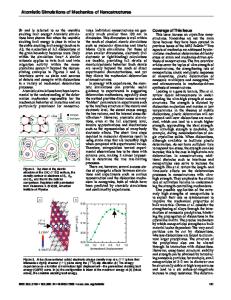Atomistic Simulations of Nanoporous Anodic Aluminum Oxide
- PDF / 201,067 Bytes
- 6 Pages / 612 x 792 pts (letter) Page_size
- 3 Downloads / 516 Views
0900-O12-17.1
Atomistic Simulations of Nanoporous Anodic Aluminum Oxide S. P. Adiga *, P. Zapol *, ±, L. A. Curtiss *, ± * Materials Science Division, ± Chemistry Division 9700 South Cass Avenue, Argonne National Laboratory, Argonne, IL 60439, U. S. A. ABSTRACT Nanoporous membranes based on anodized aluminum oxide are prepared with atomic level control of pore dimensions and pore wall compositions by atomic layer deposition and are under investigation for use in catalysis. Simulation and modeling help to understand reactivity in confined geometry and to develop rational design of these new materials. In this context, we present results of molecular dynamics simulations of amorphous aluminum oxide surfaces. The surface structure is discussed in terms of density profiles, bond angle distributions and coordination numbers of surface atoms. INTRODUCTION Nanostructured membrane catalysts based on anodized aluminum oxide (AAO) hold promise for improving catalyst performance and stability. The ability to design AAO membranes with tailor-made compositions makes them an ideal support for ultrauniform catalysts. AAO has tunable pore diameters as small as 30 nm [1], which can be further shrunk to only a few nanometers by atomic layer deposition (ALD) of amorphous Al2O3 layers with precise control of stoichiometry and thickness [2]. The surface structure of these alumina films is of great interest since they serve as a support for highly dispersed catalytically active species. Additionally, ALD of Al2O3 has been used to form amorphous thin films for potential applications as a high-k dielectric material [3]. Because of the role that amorphous alumina plays in these applications, it is important to gain understanding of the surface structure in terms of local atomic arrangement. Understanding the structure with respect to coordination number and short range order is essential in identifying active sites on the surface for catalytic applications and in developing growth mechanisms by ALD. Since the surface structures of crystalline forms of alumina, such as α-alumina and γalumina are well established, many computational investigations of catalytic reactions, e.g. [4] and ALD growth, e.g. [5], have been performed on these alumina surfaces. However, it is not evident if the structures and properties of these highly ordered surfaces can be used to represent those of amorphous alumina since coordination numbers, site distribution and surface energies can be quite different in these two cases. Therefore, computational studies of amorphous alumina surfaces are vital to the understanding of their surface chemistry and provide realistic models of these materials. In the past, molecular dynamics (MD) simulations have proved to be successful in investigating surfaces of various amorphous materials. For example, MD simulations have provided complementary information to experimental surface analysis techniques in understanding the structure of amorphous silica surfaces [6]. While, α [7] and γ-alumina [8] surfaces and bulk amorphous alumina
Data Loading...










